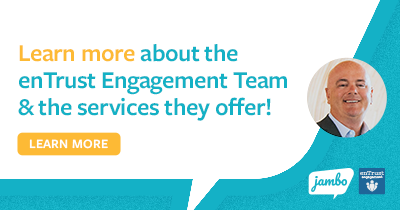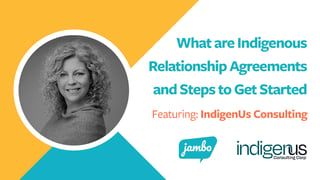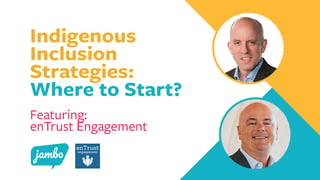
How ESG reporting and reconciliation interconnect and the importance of effective reporting and tracking on this journey
Joining Jambo for this Q&A blog is Michael Reid, one of the Principals at enTrust Engagement Inc. (enTrust Engagement). To view the enTrust team bios, visit the enTrust Engagement team page.
"enTrust engagement Inc. provides a full spectrum of practical, forward-thinking solutions in the complex and rewarding areas of Indigenous / Tribal relations, stakeholder and community engagement, local and Indigenous / Tribal business development, government relations and overall sustainability performance."
Michael has been in the Indigenous and stakeholder relations space for over twenty years. He has led Indigenous Relations teams for multi-national energy companies in both Canada and the United States.
For today's blog, Michael has offered his perspective on the interconnections between ESG reporting and Reconciliation.
In this blog, we'll cover:
- How would you describe ESG reporting to someone new to this space?
- How would you describe Reconciliation?
- What ways do you see ESG and Reconciliation interconnecting?
- Why is this interconnection so important?
- What are some of the benefits of focusing on improving ESG reporting?
- What are some beginner steps for organizations focusing on Reconciliation and improving their ESG reporting?
- How can good tracking and reporting help this process? How can people improve their tracking and reporting efforts?
- How can enTrust Engagement help organizations on this journey?
Q: How would you describe ESG reporting to someone new to this space?
In its simplest form, ESG refers to how a corporation or entity performs in three core areas: Environment, Social and Governance. Performance in these areas is often compared to standards that have been primarily set for the investment community.
- Environmental standards – focus on performance related to such issues as emissions, GHGs, water, land use and impacts, resource depletion and climate change;
- Social standards – criteria often include categories such as human rights, employee relations, diversity, local community engagement, health and safety;
- Governance – will focus on how a company is governed, policies, board representation, political lobbying etc.
Access to capital

What is significant is the rapid importance ESG plays in the corporate space and the critical role it will continue to play in the ability for corporate entities to access capital from the investment community.
The areas examined in the ESG space and their associated standards used to be seen by corporations as entirely a risk and liability – something that was not well contemplated in consideration of risk capital. More and more, we are witnessing corporations looking at ESG as an opportunity area in which they can differentiate themselves and, in doing so, have greater access to capital and numerous other important benefits.
Standardization
There is also a strong push for standardization as it relates to reporting on ESG efforts. Now, due to pressing issues like climate change and diversity, we are seeing more investment funds requiring a clear understanding of how corporate entities are managing these areas as they go about their business. In seeking a clear plan, the investment community wants to see common standards being reported on, so they can understand, in a consistent way, the risks associated with their capital.
It is amazing to see that funds associated with ESG – those compliant with standards – are now in the tens of trillions of dollars. In Canada alone, they are estimated to be at a few trillion dollars. We see this only becoming more prominent in the near future, especially with our own federal government's focus on these issues and the Biden Administration’s focus in the United States.
Back to the Top!
Q: How would you describe Reconciliation?
We think it's important that Indigenous communities and Indigenous peoples are the ones to describe what Reconciliation is – for enTrust, we look to how Indigenous leaders involved in Reconciliation describe what it means.
When Justice Murray Sinclair was leading the Truth and Reconciliation Commission, his commentary on Reconciliation focused on re-setting the relationship between Indigenous and non-Indigenous people into future generations, with a need to agree on what the relationship must look like in the future – a relationship of balance.
The Commission defined Reconciliation as "establishing and maintaining a mutually respectful relationship between Aboriginal and non-Aboriginal peoples in this country. In order for that to happen, there has to be awareness of the past, acknowledgement of the harm that has been inflicted, atonement for the causes, and action to change behaviour."
In terms of how to do this, the Commission provided a guide by establishing 94 Calls to Action, focusing on what government, the church, corporations, other organizations, and individuals could do to reconcile the relationship. At enTrust, we really believe these are there for all Canadians to look at and to respond to in some shape or form.
Back to the Top!
Q: What ways do you see ESG and Reconciliation interconnecting?
When you start to consider the role of ESG in corporate ambitions, enTrust anticipates some interesting areas of contemplation as it relates to Indigenous inclusion and the work we do in this space with both corporations and Indigenous communities.
To learn about Indigenous Inclusion Strategies and Where to Start, check out the blog with enTrust Engagement
Mark Podlasly and the First Nations Major Projects Coalition's (FNMPC) have identified that there is often a lack of Indigenous input into the ESG standards that have been created. The FNMPC is challenging this omission and highlighting the risks for corporations relying on compliance with ESG standards that lack this valuable Indigenous input. While Canada is in the process of introducing UNDRIP legislation, it only makes sense that once this legislation shows up in regulation, it would be wise for corporations to have an ESG framework that speaks to standards that have Indigenous input.
Secondly, we see a strong nexus – or interconnection – between the growing emphasis on ESG standards and Reconciliation, especially if there has been the respectful inclusion of Indigenous voices into the development of the standards. If you consider the Calls to Action areas (such as Child Welfare, Education, Language, Culture, Health, Justice, Equity, the Call for Corporations to respond and others), it's not hard to see the interconnection.

Back to the Top!
Q: Why is interconnection so important?
enTrust is especially interested in working with corporations and communities around identifying the interconnectedness in the E and S space (i.e., Environment and Social). We believe there are ways in which corporations can respond to the ESG requirements in these spaces while contributing to Reconciliation.

We’re often contacted by corporations across Canada who want to understand how they can contribute to Reconciliation. Historically, we tend to focus on Call to Action #92 around Business and Reconciliation. And while this is a good starting point, what’s compelling about overlaying an ESG lens and the associated standards (standards the corporation may already be trying to comply with), is you begin to push the corporate Reconciliation response beyond #92 and into areas that have potentially been the purview of the government or other entities.
A clear example of this – and I don't assume to know if this was their intention – is Cenovus Energy's Indigenous Housing program. Cenovus already has a significant dollar commitment to working with Indigenous companies, which is traditionally what you can find within Call to Action #92. But they’ve also made a $10 million per year for at least 5 years commitment to work with First Nations and Métis communities to help address housing issues . This choice certainly pushed the boundaries of a corporate response to Reconciliation Call to Action #92 as it’s within Actions traditionally identified for the government to respond to. At the same time, the housing commitment by Cenovus also responded to some core Social considerations in the ESG realm – such as human rights and community engagement. As mentioned, I can’t speak to all the reasons for this decision; however, a choice like this can certainly be leveraged for compliance to ESG.
We also believe there are some ways in which corporations, while addressing areas such as GHGs and other environmental issues (like commitments to reach net-zero by 2050), can partner with Indigenous communities for multiple benefits across the ESG spectrum and the Reconciliation Calls to Action. For example, through their net-zero goal, let's say a company goes about trying to capture methane in their operations. In this example, there may be an opportunity to partner with an Indigenous community that has identified food sovereignty as an important issue. By capturing methane and then utilizing it to fuel something like a greenhouse, there's an opportunity to partner with a community in addressing a food sovereignty issue while also working towards a corporate ESG goal.
Back to the Top!
Q: What are some of the benefits of focusing on improving ESG reporting?
When we think of reporting on ESG, we automatically return to the conversation around the standards that one is being asked to report on. It's no secret that there is a need to reduce the number of standards currently being used in the ESG space and develop a set of core standards to focus efforts.
Beyond trying to land on a core standard, we would expect that given the growing significance of ESG reporting, there will be more regulatory rigour around this reporting. For example, some companies in the US are adding ESG disclosures to their securities filings, and we've seen the US Securities and Exchange Commission recently setting up a 22-person enforcement task force to examine misconduct related to ESG reporting with a strong focus on Climate reporting (which is an emphasis of the current Biden Administration). We are seeing new checks and balances to ensure companies are doing what they say they’re doing. As a corporation, you want to ensure you have very strong and rigorous reporting in place that can hold up to audits and regulatory reviews.
In addition to improving reporting in response to regulatory rigour, there is also the ability to ensure your ESG reporting is getting to the heart of what is important. If you contemplate the FNMPC's push for greater Indigenous inclusion in ESG standards, by improving your reporting to reflect this greater inclusion, you increase the likelihood that you are reporting on areas that are of value to Indigenous communities too. We would suggest that strong ESG reporting may further ensure you are aligned with Indigenous communities on what is important to them.
Back to the Top!
Q: What are some beginner steps for organizations focusing on Reconciliation and improving their ESG reporting?
The first step is to create understanding by listening to what Indigenous peoples and Indigenous communities are saying regarding Reconciliation and what it means to them. Too often, this is assumed, and then we move to plan and action without that foundation of understanding. We need to respect the uniqueness of Indigenous communities and, therefore, the uniqueness of their response to what it means.
The second step is strategic planning around that understanding. By working with the Indigenous Nations and understanding what's important to them (whether that's food sovereignty, housing, business development etc.), you can start identifying those nexuses between what your organization needs to do from an ESG perspective and what's important communities and can be accomplished from a Reconciliation perspective – creating a strategic plan from there.
In planning with corporations, we focus on areas and opportunities for greater Indigenous inclusion within the business and stronger alignment with their understanding of what is important to communities. At the same time, enTrust is uniquely positioned because we work with both corporations and communities. Through this process, we discover unique and interesting ways to find mutual benefit, and we believe it is also through this process that we can begin to realize the strong nexus between ESG and Reconciliation.

Back to the Top!
Q: How can good tracking and reporting help this process? How can people improve their tracking and reporting efforts?
Our work with corporations results in a plan with clear objectives, accountability and timing. Quarterly and annually, we review and update the plan to track progress and report out accordingly. If good tracking and reporting are taking place, then a corporation should have the ability to leverage this work in its ESG reporting. And if you assume there will be more rigour required with ESG reporting and greater inclusion of Indigenous perspectives in standards, it makes sense that good tracking and reporting are critical and will help you make sure you are staying accountable to your efforts and moving in the right direction.
To improve, or even start your tracking and reporting efforts, there are at least two important considerations: Do you have a clear understanding of what you are reporting in response to (i.e., the standards) and do you understand where this may go in the future? Corporations need to think about the push for fewer standards and the push by entities (such as the FNMPC) for greater Indigenous inclusion in these standards. You want to be proactively thinking about all of this as you are doing your own tracking and reporting. Additionally, if you start improving your tracking and reporting now, it will be a natural part of your process and will not be as challenging to adapt and respond to changes down the road.

Another important consideration is regarding the system you use for your tracking and reporting. Throughout our careers, we have been part of companies that have brought in large, complicated systems that promise an immense amount of functionality but once implemented, it is too cumbersome, and those who need to track begin to loathe it and then avoid it. Therefore, the system you choose to capture your reporting needs to be effective, efficient and intuitive, or it won't get used. enTrust has had experience working with Jambo throughout North America, and this is where Jambo's systems approach sets it apart, as it is easy and intuitive software.
Back to the Top!
Q: How can enTrust Engagement help organizations on this journey?
When you consider the possibilities around the ESG and Reconciliation nexus, enTrust is uniquely positioned in that we work with both corporations and Indigenous communities in this space. We literally have the ability to work with corporations and communities to clearly identify the nexus – the interconnection – and then define a plan for the possibilities to become a reality.
For example, we are currently working with Nations in Saskatchewan, Ontario and Manitoba, on initiatives such as First Nation-owned and managed water authorities (drinking & wastewater), food sovereignty projects and economic development projects. We are convinced these types of initiatives, if desired by communities, can have corporate participation that will both respond to Reconciliation Calls to Action and fulfill ESG requirements. enTrust is well-positioned to be a facilitator in supporting what it will take to make this happen – to help corporations and Indigenous communities come together in the ESG and Reconciliation space.







